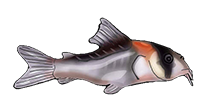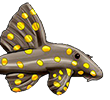1. Water parameters
a) Temperature range. 74-75f
b) pH. 7.2-7.4
c) GH.
d) KH
e)Ammonia, Nitrite, Nitrate, levels. 0,0,10-15
f) Water change frequency. 50% weekly
2. Tank set up
a) Size. 20 high
b) Substrate. Caribsea sand
c) Filtration. Marineland penguin 200
d) Furnishings. Slate caves, driftwood, flower pots, heavily planted
e) Other tank mates. 2 juvenile ancistrus, 6 cory. Metae, handful of juvenile swords (which the cats usually eat)
f) How long has it been set-up? 2 years
g) When was the last new fish added? Every few months I add sword or guppy fry as live food
h) Foods used and frequency? Kens earthworm pellets, NLS pellets, plecocaine, cobalt flake, frozen bloodworms, mysis shrimp. Feed once daily alternating what they get, with a day of fasting every 7-10 days
3. Symptoms / Problem description
Emaciation, lethargy, death
4. Action taken (if any) moved to hospital tank
5. Medications used (if any) metro/prazi, levamisole






